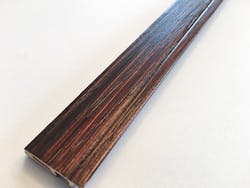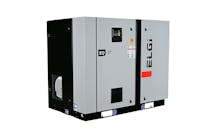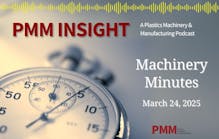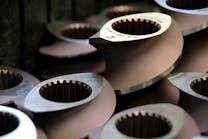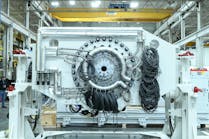Profile extruder Formtech Enterprises Inc., Stow, Ohio, has its sights set on growing its wood-plastic-composite (WPC) profile business under the new leadership of President Amy Reynallt and VP of business development Herb Hutchison.
"There is a lot of wood composite need out there," Hutchison said during a recent tour of Formtech's facility in Fairview, Pa. "It is a market that is growing. I'm amazed with the numbers; now, decking drives most of that. With some of the larger deck manufacturers, they have sweet spots and they do things extremely well. I'm saying that as a general statement; they have to in a commodity product. That means not focusing on things that are out of their wheelhouse. We can help with those, and we work with companies to provide a PVC-based wood-plastic composite." Hutchison's background includes time with machinery maker Milacron LLC as director of international business development and executive roles with Crane Plastics, Columbus, which specializes in profile extrusion and now operates as Engineered Profiles LLC.
There are several tricks to successfully bringing these types of products to market. Profile performance depends on a number of factors, including moisture absorption, thermal expansion, shear strength and coefficients of friction. The products have to perform in their environment, which typically means outdoors and in varying weather conditions. Also, the products have to achieve acceptance in the construction industry, whether it is among contractors or the customers of stores such as Home Depot or Lowe's.
As an example, Formtech developed a PVC-based WPC for a leading manufacturer of windows and doors. The material contained 30 percent wood fiber, and Formtech had tailored fiber, polymer and additive content based on the performance requirements of the application.
Formtech varies the wood fiber content to meet performance-related criteria. The product is extruded via a twin-screw extruder at Formtech's facility in Athens, Ga. The extruder has adequate venting to allow moisture to escape during the process, Hutchison said. "Moisture content is critical to successful WPC extrusion, and twin-screw extruders are very efficient in removing moisture," he said.
Hutchison highlighted the coefficient of expansion (COE) achieved through use of the PVC-based WPC raw material. He said the PVC-based WPC achieved better COE for the window and door manufacturer than 100 percent plastic.
"This is very important for products used on the exterior of a home, to protect from gaps and/or buckling on items such as a glazing bead on a window," he said.
Specially designed extrusion dies and systems for calibration and efficient cooling of the profile are required to manufacture these products, Hutchison said. "Wood is a great insulator and gives up heat reluctantly," he said. "As a result, controlled cooling of the product is very important for profile integrity."
Material Selection: PVC over HDPE
Formtech is using PVC for its extrusions because olefin-based WPC products are very difficult to stain due to the wax-based nature of the compounds, Hutchison said. PVC-based WPC products, with proper material formulations and tooling, can be stained for enhanced aesthetics.
There are a couple of WPC-type products. One is a PVC-based extrusion with a WPC cap, in which a PVC substrate is used and a cap layer of PVC-based WPC is co-extruded onto exposed surfaces. The second type is a PVC-based WPC extrusion.
"With the right material and tooling combinations, these products are stainable," Hutchison said. "In addition, products can be dual- or even tri-extruded for functionality. For example, this technique can be used to add highly weatherable capstocks to exposed areas of a profile, and/or to add flexible sealing fins to address water penetration or attachment to mating parts."
Tooling and Machinery
The tooling and machinery is key to achieving these characteristics. Staying competitive in the market requires Formtech to rely on its suppliers, Reynallt said.
"We really reach out to those trusted suppliers to figure out what innovation we want to do next," she said. "We are really looking at what the market is asking for. Is it a new material? Is it a new profile configuration? What is it that the market is demanding? And that is where we start. And then we use the supply base that we have and we say, 'This is what we're trying to do. Help us figure out what the overhead looks like to make this happen.' Is it that we need a bigger extruder? Do we need a different screw and barrel? A different chilling system? We really look to the advice of the experts in those areas to help us figure out what to do next in terms of machinery and equipment."
The company works with a variety of major extruder and tooling manufacturers, including KraussMaffei, American Maplan and Milacron. Its nondisclosure agreements preclude it from identifying suppliers of specific, key components.
Formtech builds a lot of its own tooling.
"You keep yourself at the leading edge of technology when you go outside and take a look at what others are doing," Hutchison said. "We do not profess to know it all. We know a lot about tooling. If we can learn from some of the good people that build tools, we have developed partnerships with them. We are really not competitors with them. They know we're going to build some tools. And others we'll go outside for. If you keep that kind of relationship, you can always stay at the forefront. We have the ability to run dual-extruded parts, tri-extruded parts, and it's driving that technology that keeps you competitive. We are not just a commodity extrusion manufacturer. Those companies have it tough these days because there are always 14 more of them."
Secondary process: Embossing
Formtech does embossing inline; this is done by using texturing equipment similar to what is used in manufacturing vinyl siding. The process integrates a randomness to the texture also.
"Embossing inline provides consistency that you would not be able to duplicate in a secondary operation, especially on the ends of the product," Hutchison said. "This is due to pressure release on both ends of the part versus the pressure being applied by the embossing rolls and equipment. Extrusion is a continuous process and this eliminates the issues with inconsistency at the end cuts."
Angie DeRosa, managing editor
aderosa@plasticsmachinerymagazine.com
Contact:
Formtech Enterprises Inc.,
330-688-2171, www.formtech.com

